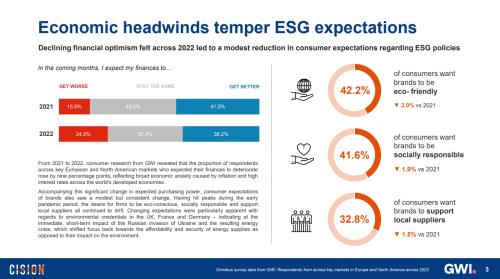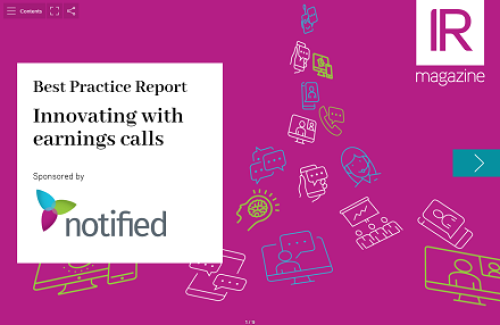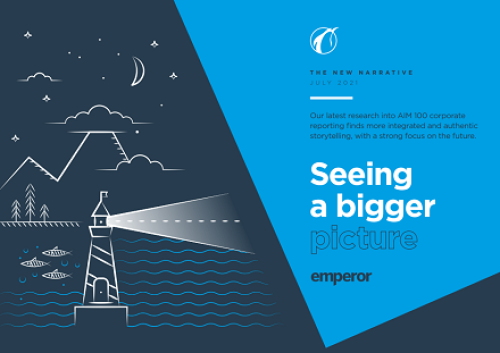Tim Human runs down trends likely to influence next year’s batch of annual reports
Ten years ago, many companies liked to send a photographer off round the world for weeks on end, snapping pictures for their annual report. Stopping off in each of the company’s global locations, the photographer would faithfully record the company’s people and products in color photographs that would later adorn the print product.
You don’t see as much of that anymore. The practice has tailed off quite a bit, thanks mainly to budgetary pressure, according to Sallie Pilot, director of corporate reporting at Black Sun.
The money left in the pot, meanwhile, is being spent more and more on the online report. With an increasing number of shareholders accessing the annual report online, it makes sense to divert more of the limited resources available to that area. Looking forward to next year’s batch of annual reports, designers see more of the same: budgets under pressure, print reports stripped back and more attention paid to the online product.
‘Companies are focusing more time and effort online; consequently, the production values of printed reports are becoming more modest,’ says Adrian Parker, client partner at SAS London. ‘For example, we’re seeing fewer big, full-color images and less complex, intricate and colorful design. What we’re seeing more of is uncomplicated, utilitarian design.’
A case in point is IT services company Logica, says Parker, which for the last few years has produced simpler printed annual reports with his firm. ‘This year, it’s a very straightforward document that concentrates on the clarity of the information. From a production point of view, it’s a very easy document to produce.’
Onus online
As the printed annual report gets stripped back, the online report grows in importance. The trend in this space is toward more HTML reports. Taken together, European and US companies from the leading indices have seen a steady rise in the number of companies using HTML reports, according to research from online design company Nexxar.
There are significant national differences in the rate of adoption, however. Nexxar’s research finds that between 2010 and 2011, the number of companies producing HTML reports fell in Germany and Austria. The UK, on the other hand, saw adoption continue to rise and hit almost 70 percent of companies this year. France is something of an anomaly: in 2011, just 5 percent of the CAC 40 produced HTML reports.
Thomas Rosenmayr, CEO and founder of Nexxar, says the mixed picture is in part down to the different ways countries have reacted to budgetary pressure. In Germany, for example, companies cut back on HTML, he says, while in the UK there was an uptick in the use of hybrid HTML reports, which combine HTML with downloadable PDF sections to save costs. As for France, Rosenmayr says the country just ‘doesn’t get the point’ of HTML yet.
Indeed, the question of whether to go hybrid or not is one of the issues facing companies looking ahead to their 2012 report. If you’re unfamiliar with what they’re like, check out BAE Systems’ 2011 report, which offers the company accounts and notes to the group accounts as PDFs.
Handling the hybrid
If you do decide to plump for a hybrid, the next question is which bits to make HTML and which bits to have as PDFs. ‘The topic that’s really going to engage people this year is the emergence of the hybrid report,’ predicts Nick Smith, managing director at Living Reporting. ‘When we look at the analytics from our clients’ online sites, the greatest number of hits in the full-HTML sites is in the financial statements section and the notes section.
‘So when we are in discussions about hybrid reports, we advise not to take a hybrid approach to the back end. I would argue that there are other sections – perhaps in corporate governance, perhaps in the remuneration report – that would be more appropriate in PDF form.’
The drawback of hybrids, as you would imagine, is that you lose some of the features of a full HTML report – you can’t link to text in the parts available only as PDFs, for example.
Despite the rise of the cost-effective hybrid, one designer believes the savings derived from them are becoming minimal. ‘In terms of cost savings, I don’t think it’s dramatic in terms of doing a PDF back end,’ says Brett Simnett, a reporting consultant at Radley Yeldar. ‘The transformation of the accounts section from the printed version into the online version is not that difficult anymore, so if firms are looking for a massive cost saving by moving to hybrid, I’d say that’s not really [likely].’
Mobile options
A growing number of companies are using the mobile options on offer. It’s a timely move, given that more and more information is being consumed over mobile devices. A study by Morgan Stanley predicts the tipping point will come in early 2014, when mobile internet users will overtake desktop internet users.
Options available to companies include ‘mobile-lite’ reports, which adapt to the smaller screen when accessed through a mobile device, and annual report apps. When deciding whether or not to have an app, you need to start by thinking about your audience and how it consumes information, advises Simnett. ‘Don’t produce a mobile app just for the sake of it,’ he cautions. The costs can rack up when creating apps for different devices, he adds, so you might want to focus on just one or two operating systems. Like other parts of the annual report, it’s about squeezing as much value out of the budget as possible.
Should IR take control of the annual report project?It’s almost unheard of for IR to take the lead in the annual report project. While IR often provides input, it’s usually left to another department to boss proceedings. One company that bucks the trend, however, is FTSE 250-listed Logica. At the IT services group, the IR team runs the annual report show and makes sure the other departments involved stick to the schedule. For next year’s report, the project is being handled by investor relations assistant Lucy Driver.IR hasn’t always handled the annual report project at Logica; it used to be the responsibility of corporate communications. As IR was handling so much of the drafting and liaison with senior management, however, it made sense for IR to take on responsibility as overall project manager, explains Driver. ‘For us, it works really well because IR has such a close relationship with members of the board and the executive committee, so it just opens a lot more doors,’ she points out. ‘If you’re in finance or corporate communications, you might not have the same sort of access to those people, which can make it very difficult getting meetings arranged, sending documents, printing stuff off, and being able to chase people up.’ Is it a tough project to manage? ‘I don’t think it’s easy for anybody,’ muses Driver. ‘It’s a very long and difficult process for – hopefully – a good document in the end.’ |
This article appeared in the October print edition of IR magazine.










